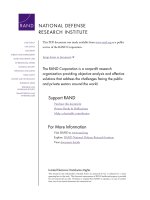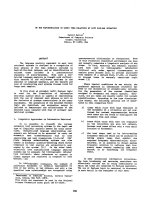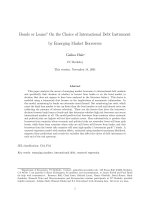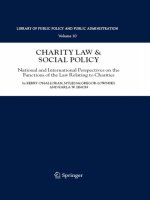Survey on the ability of cod and SS treatment of aquatic waste water by aerobic biological technology with bagasse substrate
Bạn đang xem bản rút gọn của tài liệu. Xem và tải ngay bản đầy đủ của tài liệu tại đây (689.31 KB, 7 trang )
Thu Dau Mot University Journal of Science
Issue 1(40)-2019
SURVEY ON THE ABILITY OF COD AND SS TREATMENT OF
AQUATIC WASTE WATER BY AEROBIC BIOLOGICAL
TECHNOLOGY WITH BAGASSE SUBSTRATE
Truong Quoc Minh1
1
Thu Dau Mot University
ARTICLE INFO
Article history:
Received Jul. 27. 2018, Accepted Dec. 31.2018.
Contact:
Abstract
Bagasse is a cheap material and the collection of bagasse is easy from sugarcane shops. This
survey used cane bagasse as a substrate for aerobic biological modeling to treat aquatic waste
water, bringing about economic, technical and environmental benefits. This study was conducted at
three different loads: 1.2kg COD/m3.day; 2.4kg COD/m3.day; 3.6kg COD/m3.day. The results
showed that COD removal efficiency was 99.15%, the optimum load of the research model was
2.4kg COD/m3.day for the SS removal efficiency reaching 92.49%.
Keywords: aquatic waste water, bagasse, loads, removal efficiency
INTRODUCTION
The aquatic processing industry is one of the key industries of our country, according to the
General Statistics Office of Vietnam (2014), by 2013 there will be 570 aquatic processing
establishments on an industrial scale and thousands of small processing units, handcrafted
households with a processing capacity of about 2.5 million tons per year. In addition to the
economic benefits that this industry brings, waste water from processing establishments polluting
the environment, as most of them are concentrated on some locations such as downstream rivers
with high density and large processing capacity. And with raw processing technology, for exporters
of raw materials, only about 60% for export, the rest is thrown out or used inefficiently polluting the
environment (Le Hoang Viet, 2015).
At some aquatic processing plants, wastewater is mainly generated during the process of
washing and processing raw materials. Due to the diversity of types and forms of processing, the
components in the wastewater of the fisheries sector are extremely complex and contain a lot of
waste and are itself a threat to the aquatic environment because aquatic waste water has a very high
organic content, COD ranges from 1000 to 1200 mg/l, BOD5 from 600 to 950 mg/l (Lam Minh
Triet, 2014).
Apart from the enterprises operating in the concentrated industrial zones, there are many
small processing establishments located in the residential areas also contributing to pollution. These
43
Truong Quoc Minh
Survey on the ability of cod and ss treatment...
facilities are often not invested in machinery and technology, and are often found to be discharged
directly into the environment.
And in practice, the application of various technologies and methods for treating fishpond
wastewater meets the emission standards is a difficult issue. With the aim of diversifying treatment
methods and more options for wastewater treatment, the project "Survey on the ability of COD and
SS treatment of aquatic waste water by aerobic biological technology with bagasse substrate" with
the expectation that it can be applied in practice to treat wastewater for craft villages, small and
medium aquatic producers as well as to solve some current environmental pollution situation.
MATERIALS AND METHODS
Materials
Modeling
Table 1. Parameters of aerobic biological tank size.
No
1
2
3
Parameter
Length
Width
Height
Unit
cm
cm
cm
Value
30
35
45
Notes:
1. Waste water input
2. Aerobic tank with filter material
3. Waste water output
4. Quantitative wastewater pump
5. Valve
6. Coil
7. Bagasse substrate
8. Waste water
Figure 1. Research model
Research waste water: This study was conducted with artificial aquatic wastewater to
evaluate the treatment effect at different loads. The composition and characteristics of wastewater
are shown in the following table:
Table 2. Characteristics of research aquatic waste water
No
1
2
3
4
5
6
Parameter
pH
COD
TSS
NH4+
NO2NO3-
Unit
mgO2/L
mg/l
mg/l
mg/l
mg/l
Value
7,5 (6,5 – 8,5)
1300 (400 – 2200)
1400 (1100 – 1700)
250 (100 – 400)
4 (1,2 – 6,4)
14,9 (1,3 – 28,4)
Activated sludge: Activated sludge was taken from the settling tank II of Viet Huong I
Industrial Park wastewater treatment plant. Every day, add aquatic waste water to feed the
microorganism to adapt and develop (by removing the water layer above and adding waste water).
44
Thu Dau Mot University Journal of Science
Issue 1(40)-2019
Bagasse substrate: Bagasse is a cheap material, and it is easy to collect bagasse from sugar
cane juice shops. Sugarcane bagasse after harvesting will be dried because the bagasse is fresh and
high moisture. After the dry bagasse, sugarcane residue was compacted into compact blocks.
METHODS
Experiment 1: Determine the volume of the substrate
Table 3. Operation parameters determine the substrate weight
Parameter
Substrate
Weight
Waste
water
volume
COD
MLSS
DO
Unit
g/l
Exp 1
10
Exp 2
20
Exp 3
30
Exp 4
40
Exp 5
50
liter
3
3
3
3
3
mg/l
mg/l
mg/l
2000
2500
2000
2500
2000
2500
2
2000
2500
2000
2500
Substrate was stored in a 5-liter container. Measurement of COD after 1 day, 2 days, 3 days, 4
days to monitor the treatment of each batch and observe the ability of mud sticking on the substrate, the
experiment was repeated 4 times to determine the suitable substrate weight for the model.
Experiment 2: Adaptive operation
- At the stage of adaptation, model run with organic load rate (OLR) of 0.7 kgCOD/m3.day. Maintaining pH in the range of 6.5 - 8.5 is optimal from 6.6 to 7.6. Check COD : N : P ratio = 150:
5: 1 (aerobic) if nutrient deficiency (N, P) is added with NH4Cl and KH2PO4
Experiment 3: Operation at OLR of 1.2kg COD/m3.day.
Table 4. Parameter and value at OLR of 1.2kg COD/m3.day
No
1
2
3
4
5
6
Parameter
pH
OLR
COD
Q
HRT
DO
Unit
kg COD/m3.day
mg/l
l/h
h
mgO2/l
Value
6–9
1,2
831,6
2,08
19
Aerobic tank
2
3
Experiment 4: Operation at OLR of 2.4kg COD/m .day
Table 5. Parameter and value at OLR of 2.4kg COD/m3.day
No
1
2
3
4
5
6
Chỉ tiêu
pH
OLR
COD
Q
HRT
DO
Đơn vị
kg COD/m3.day
mg/l
l/h
h
mgO2/l
45
Giá trị
6–9
2,4
1663
2,08
19
Aerobic tank
2
Truong Quoc Minh
Survey on the ability of cod and ss treatment...
Experiment 5: Operation at OLR of 3.6kg COD/m3.day
Table 6. Parameter and value at OLR of 3.6kg COD/m3.day
No
1
2
3
4
5
6
Chỉ tiêu
pH
OLR
COD
Q
HRT
DO
Đơn vị
kg COD/m3.day
mg/l
l/h
h
mgO2/l
Giá trị
6–9
3,6
2494,8
2,08
19
Aerobic tank
2
RESULTS AND DISCUSSION
The result of suitable bagasse substrate weight survey for aerobic biological model.
Figure 2. Flow chart showing the COD removal efficiency of bagasse substrate
From the above chart it could be seen that during the first stage of the survey, models with
low bagasse at 10g/l, 20g/l and 30g/l gave the best treatment about COD, and 40g/l and 50g/l for
lower processing efficiency. And after the run time of the 3 replicate stages, we could see 20g/l and
30g/l on the 3 stages of the survey for poor COD efficiency. The average of 10 g/l over the next
three surveys was the best COD removal efficiency. So we chose 10 g/l as the bagasse substrate had
the optimal volume.
COD removal efficiency
From the chart above, the process of treating COD concentration through three OLR as
follows: At the OLR of 1.2kg COD/m3.day, the COD was well treated during the day with the
highest efficiency of 95.71%. At the OLR of 2.4kg COD/m3.day, the COD was well treated during
the day with the highest efficiency of 97.86%. And at the OLR of 3.6kg COD/m3.day, the COD was
well treated during the day with the highest efficiency of 90.95%. Thus, at a OLR of 2.4kg
COD/m3.day, COD concentration is best treated with a yield of 97.86%.
46
Thu Dau Mot University Journal of Science
Issue 1(40)-2019
Figure 3. COD removal efficiency at OLR of 1.2kg COD / m3.day
Figure 4. COD removal efficiency at OLR of 2.4kg COD / m3.day
Figure 5. COD removal efficiency at OLR of 3.6 kgCOD / m3.day
47
Truong Quoc Minh
Survey on the ability of cod and ss treatment...
SS removal efficiency
Figure 6. SS removal efficiency at OLR of 1.2kg COD / m3.day
Figure 7. SS removal efficiency at OLR of 2.4kg COD / m3.day
Figure 8. SS removal efficiency at OLR of 3.6kg COD / m3.day
48
Thu Dau Mot University Journal of Science
Issue 1(40)-2019
From the chart above we can see the process of processing SS concentration over three loads
as follows: At the OLR of 1.2kg COD/m3.day, the SS concentration was well treated and stable for
10 days (best treatment at 92.49% treatment efficiency). At the OLR of 2.4kg COD/m3.day, the SS
concentration was treated more and better for 10 days (best treatment at 92% efficiency). At a load
of 3.6kg COD/m3.day, the SS concentration was best treated at 75.81% and other days the SS
concentration was unstable.
CONCLUSIONS
After studying the aerobic biological model with bagasse substrate for artificial aquatic waste
water, the results were as follows:
- The weight of bagasse suitable for the aerobic biological model for treatment of artificial
aquatic waste water was 10 g/l.
- With a bagasse of 10 grams per liter and an input COD concentration of 800-2,500 mg/l, the
COD removal efficiency of the aerobic biological model was 99.15%
- The OLR of 2.4kg COD/m3.day was the load having the best processing efficiency with the
processing efficiency of SS was 92.49%.
REFERENCES
Aline Sartorio Raymundo, Romina Zanarotto, Marciela Belisario, Madson de Godoi Pereira,
Joselito Nardy Ribeiro, Araceli Veronica Flores Nardy Ribeiro, (2010). Evaluation of
sugarcane bagasse as a bio-absorbant in textile wastewater treatment with congo red dye
causing cancer, Brazilian Archives of Biology and Technology.
Lam Minh Triet (2014). Urban and industrial waste water treatment - Project design calculation.
Ho Chi Minh City: National University Publishing House.
Lam Vinh Son, Nguyen Tran Ngoc Phuong (2011). Study on improving the efficiency of animal
wastewater treatment using Biogas model with sugar cane bagasse, Hutech University of
Technology Press.
Le Hoang Viet and Nguyen Vo Chau Ngan (2014). Waste Water Treatment Technology, episode 1.
Can Tho: Can Tho University Press.
Le Hoang Viet, Nguyen Vo Chau Ngan, Ta Hoang Ho and Nguyen Van Phu (2015). Efficiency of
wastewater treatment of aquatic products by submerged aerobic biological filter. Can Tho
University Press.
Nguyen Van Phuoc (2014). Biological wastewater treatment program. Ho Chi Minh City: National
University Publishing House.
49









